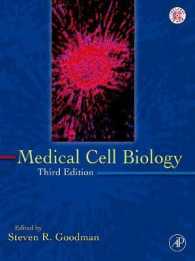- ホーム
- > 洋書
- > 英文書
- > Nature / Ecology
Full Description
The prominence of the carp group of fish is widely recognised in three important economic areas: food production, recreation and the ornamental market. Carp species thus represent over 50% of world fish production and are vital to the economic stability of several countries and global regions. It is therefore crucial that the health of these cultured aquatic species is properly considered and maintained to ensure the sustainability of production and recent disease epidemics, for example grass carp reovirus infections in China and koi herpesvirus disease in Asia and Europe, have caused widespread and devastating effects on the aquaculture industries. This book thus examines how the diseases of carp species can be properly identified, monitored, treated and prevented. It specialises on the most prominent globally occurring carp species, such as Cyprinus carpio (common carp), the Carassius species, and the carp species that predominate in Europe and Asia, such as Ctenopharygodon idellus (grass carp), Hypophthalmichthys molitrix (silver carp), and Hypophthalmichthys nobilis (bighead carp). It also looks at the more specialised production of certain species, for example Catla catla (Catla) and Labeo rohita (Roho), in the Indian subcontinent. With the continuing importance of the carp group of fish, this user-friendly book presents a practical approach to disease diagnosis and treatment that covers both infectious and non-infectious diseases. The detail included about disease, clinical signs and the application of control strategies, such as management practices, therapeutics or vaccination, is an effort to considerably improve general fish health and welfare.
Contents
Part One: Introduction Chapter 1: World carp production: economical and societal importance Chapter 2: Range of species and production units Chapter 3: Getting started: the norms in biological structure and diagnostics Chapter 4: Examination procedure, pathological terms and clinical signs Chapter 5: Management practices, therapeutics, and vaccines Part Two: Infectious Diseases Chapter 6: Viruses Chapter 7: Fungal and fungal -like pathogens Chapter 8: Bacteria Chapter 9: Myxozoan Diseases Chapter 10: Protozoan Diseases Chapter 11: The flukes Chapter 12: The Tapeworms (Cestoda) Chapter 13: The Nematodes Chapter 14: The Acanthocephala Chapter 15: The Crustacea Chapter 16: Leeches Chapter 17: Coinfections Part Three: Zoonosis Part Four: Non-infectious Diseases Part Five: An Ornamental Perspective








